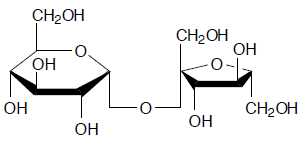Influences on Crystallization Behavior, Saccharose Solutions
Sample
D(+) Saccharose solution, 20 weight % in water (= 1.05 mole %)
Application
Inactive ingredient (solution stabilizer)
Conditions
Measuring cell: DSC820
Pan: Aluminum 40 µl, hermetically sealed
Sample preparation: One drop of solution is weighed into the pan using a fine pipette, sample weight 2.260 mg.
DSC measurement: Cooling from 25 °C to -50 °C at -1, -2, -5, -10, -20 K/min. The same sample is used for all the measurements. Heating from -50 °C to 25 °C at 5 K/min.
Atmosphere: Nitrogen, 80 cm3/min
Interpretation
The curves show that crystallization and melting processes can be measured with the DSC. At low cooling rates, the onset temperatures are almost constant, but are displaced to lower values (supercooling) at higher cooling rates. At very high cooling rates it is even possible that the solution does not crystallize but vitrifies i.e. is transformed to glassy state.
The melting point depression and the ‘purity’ of the water can be calculated from the melting peak.
Evaluation
| Cooling rate (K/min) | Onset, °C | ΔH, J/g | Effect |
|---|---|---|---|
| -1 | -15.0 | 173.2 | crystallization |
| -1 | -15.3 | 168.3 | - |
| -5 | -15.8 | 162.5 | - |
| -10 | -15.3 | 170.0 | - |
| -20 | -23.0 | 157.3 | - |
| +5 | -3.8 | 153.5 | melting |
Purity calculated using the
Melting peak: 99.02 mole % (theoretical value: 98.95)
Melting point depression: -1.76 °C
Conclusion
The onset temperatures of the melting and crystallization processes are different. Crystallization processes are controlled kinetically by nucleation and are dependent on the cooling rate and the amount of sample (number of nuclei present). The onset temperatures of melting peaks are not normally subject to disturbing influences.
Influences on Crystallization Behavior, Saccharose Solutions | Thermal Analysis Application No. HB819 | Application published in METTLER TOLEDO TA Application Handbook Pharmaceuticals